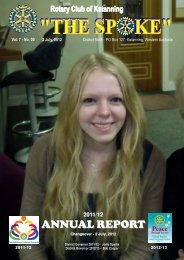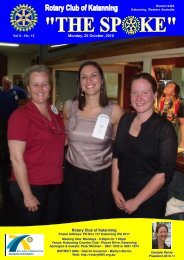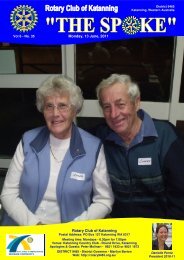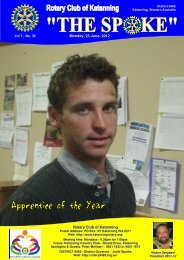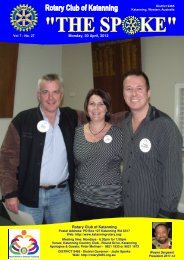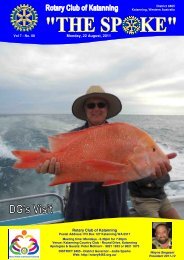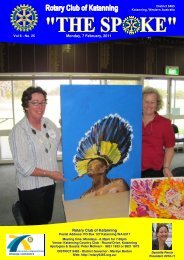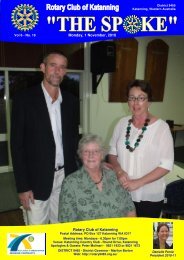Vol 6-12-Sept 27 - Katanning Rotary Club
Vol 6-12-Sept 27 - Katanning Rotary Club
Vol 6-12-Sept 27 - Katanning Rotary Club
- No tags were found...
Create successful ePaper yourself
Turn your PDF publications into a flip-book with our unique Google optimized e-Paper software.
FROM THE DISTRICT 9465 WEBSITEMonday, 28 <strong>Sept</strong>ember, 2010<strong>Rotary</strong> <strong>Club</strong> of <strong>Katanning</strong><strong>Club</strong> DirectorsPresident:Danielle PerrieTel: (H) 08 9822 8030(M) 0428 231 506District GovernorDistrict 9465Marilyn BartonPage 2<strong>Club</strong> ServiceJohn BarnesTel: (H) 08 9823 1170(M) 04<strong>12</strong>08<strong>12</strong>88International ServiceJulie BrownTel: (H) 08 9823 1115(M) 0408 590 006New GenerationsMarianne PerrieTel: (H) 08 9822 8036(M) 0438 345 618Community ServiceMichael HobleyTel: (H) 08 9821 4797(M) 0428 214 794Vocational ServiceDavid MeyerTel: (H) 08 9821(M) 0409President<strong>Rotary</strong> InternationalRay KlinginsmithCall for cricketloversThe call has gone out for WesternAustralian Rotarians who arecricket fans to be part of a uniqueinternational cricket festival beingheld in Perth later this year.The Australian <strong>Rotary</strong> Festival ofCricket, organised by theInternational Fellowship ofCricketing Rotarians (IFCR), willbe held at thepicturesqueLilac Hillground in theSwan Valleyfrom October24 to 29.Up to 200Rotarians areexpected totake part. Theeight teams competing willinclude two from WesternAustralia and four from theRoll on good times- in New Orleans!The <strong>Rotary</strong> Internationalconvention for 2011 will be heldin the evocative and historicsurrounds of New Orleans. Theconvention will run from 21 to 25May in the modern New Orleansconvention centre, alongside theMissouri River.“<strong>Rotary</strong> conventions are uniqueand special events, and I ampleased to invite Rotarians andtheir guests to attend the 2011 RIConvention in one of my favouritecities,” says RI president RayKlinginsmith.Preparations are being made forWestern Australian Rotarians whoOURCOVEReastern states plus one from NewZealand and a combinedinternational side drawn fromIndia, Pakistan, Sri Lanka, SouthAfrica and England.Past District Governor DavidHorsley, who is IFCR’sAustralian president, says up to200 Rotarians and partners areexpected to visit Perth for theweek-long festival.To ensure the festival runssmoothly, PDG David is seekingassistance from local Rotariansand partners – not just as playersbut also umpires, scorers, drivers,ground marshals, helpers,photographers and supporters.Information and registration formsare available at the websitewww.rotarycricket.orgor by contacting PDG DavidHorsley on 9574 04<strong>12</strong>, orhorsleys@bigpond.com Thise-mail address is being protectedfrom spambots. You needJavaScript enabled to view it.wish to share this uniqueexperience, including linking upwith pre and post-conventiontours being organised forAustralian groups by <strong>Rotary</strong>Down Under.Rotarians wishing to express theirinterest in the opportunity areinvited to contact PDG JohnKevan atjohn.kevan@naveko.comThis e-mail address is beingprotected from spambots. Youneed JavaScript enabled to viewit .More information about theRI convention can be found atwww.rotary.org/convention,www.rotarycon2011.com andwww.neworleanscvb.com/rotary.President Danielle Perrie with Ross Richardson fromthe Gnowangerup <strong>Club</strong><strong>Rotary</strong> <strong>Club</strong> of <strong>Katanning</strong>
OTHER CLUB’S PROJECTSMonday, 28 <strong>Sept</strong>ember, 2010<strong>Rotary</strong> in Papua New GuineaPort Moresby International School InteractThe Port Moresby InternationalSchool (POMIS) Interact <strong>Club</strong> issponsored by the <strong>Rotary</strong> <strong>Club</strong> ofBoroko. Interact is made up ofGrade 9 - <strong>12</strong> students aged between14 and 18 years of age attendingPOMIS and they meet Mondays atlunch time every second schoolweek. Interact has started the schoolyear with an enthusiastic group ofyoung "Interactors" who have<strong>Rotary</strong> <strong>Club</strong> of Lae –Water ProjectsThe club has currently 3 villagewater supply projects. These projectsare being done with the help ofthe St. Alberts <strong>Rotary</strong> <strong>Club</strong> inCanada who have organised fundsthrough a <strong>Rotary</strong> InternationalMatching Grant.The Villages which will benefit arein remote areas of the Morobedistrict of Papua New Guinea withoutaccess by way of road. Thevillages and brief details of projectsare:Kiemen Village - This Village islocated in the mountain ranges withthe nearest road around 3-4 hours ofwalking distance. The projectinvolves building a stone walleddam on a spring nearly a kilometrefrom the village and piping thewater to the village. The water willbe gravity fed and stored in a tank atthe village. The villagers will accessthe water from 3-4 taps connected tothe tank.elected their directors who havedecided to continue to support otherschools projects. The Interactorswill visit and select one or twogovernment primary schools anddecide how they can help out. In thepast they have provided water tanksand gutters, reading books, desks,paper and other stationery supplies.They both carry out fund raisingdrives in the school year to fundvarious projects as well asdistributing materials from the<strong>Rotary</strong> <strong>Club</strong> of Boroko Donations inKind (DIK) containers.The interact President andSecretary, together with the FacultyAdvisor, are invited to <strong>Rotary</strong> <strong>Club</strong>of Boroko meetings to discuss theirprojects and other activities.Kisengam village - This village isalso located in mountain rangeswith the nearest road around 5-6hours of walking distance. Thisvillage has some buildings withcorrugated roofing. The projectaims to catch and store rain waterfor the villagers use. The projectinvolves guttering the existingbuilding and channelling the waterto 1-2 large tanks and installing 3-4taps.Bosadi Village - This village islocated on the Morobe coast with noregular shipping links. This projectis also involves catchment andstorage of rain water and supplysimilar to the one in Kisengamvillage.The funding for these projects hasbeen received and the club iscurrently executing them.<strong>Rotary</strong> <strong>Club</strong> of <strong>Katanning</strong><strong>Club</strong> SecretaryBrent LadymanTel: (H) 08 9821 0030(M) 04<strong>27</strong> 968 533<strong>Club</strong> TreasurerMarlene ShackleyTel: (H) 08 9822 8040(M) 0428 683 601Public Relations,Spoke Editor,Arthur ToddTel: (H) 08 9821 2019(M) 0429 100 084Sergeant at ArmsGreg RammTel: (H) 08 9821 1718(M) 04<strong>27</strong> 974 452&<strong>Club</strong> OfficersGeoff BeeckTel: (H) 08 9821 4333(M) 0417 966 802AttendancePeter MolinariTel: (H) 08 9821 1673(W) 08 9821 1933ProgramArthur ToddTel: (H) 08 9821 2019(M) 0429 100 084Immediate Past PresidentNigel AitkenTel: (H) 08 9821 1690<strong>Rotary</strong> <strong>Club</strong> of <strong>Katanning</strong> Page 3
Monday, 28 <strong>Sept</strong>ember, 2010No meeting - PUBLIC HOLIDAYSUMMARY OF MEETINGMeeting - Monday, <strong>27</strong> <strong>Sept</strong>ember, 2010Group 8 Meeting - Monday, 28 <strong>Sept</strong>ember, 2010VENUE:Henry Jones Winery & Restaurant, BroomehillPRESIDING:Gnowangerup President - Dick GarnettATTENDANCE:<strong>Katanning</strong>:Danielle Perrie, Andrew Pritchard, Arthur Todd, PeterMolinari, Peter Kerin, Ian Billing, Sandra Barnes, JohnBarnes, David Meyer, Brent Ladyman, Kevin Newman,Partners: Deb BillingKojonup:Max Cussons, Frank House, Tim Trethowan, Terry Cussons,Rob Watson, Jim McGregorPartners: Rosemary Cussons, Jill House, WendyTrethowan, Ginny Cussons, Alison Watson, PamMcGregorGnowangerup:Ross Richardson, Philip Patterson, Allan Shaddick,Geoff Shepherdson, Geoff Thomson, Gavin Parnell,Mike Moore, Ken PechPartners: Kathryn Richardson, Chris Parnell, TeresaMoore, Judith Pech, Barbara GarnettGuests: Jenny SeymourWagin:Stephen Donohue, ADG Garry Griffiths, BrentonAughey, Maurie BeckerMount Barker:Andrew Fraser, Fred Mentha, Peter Thorn, BillHollingworthPartners: Leonie MenthaGuest Speakers: Ken and Judith Pech‘Montreal <strong>Rotary</strong> Convention’MEETING:Grace: Garry GriffithsPRESIDENTS REPORTS-<strong>Katanning</strong> - Danielle PerrieTonight’s MeetingThanks to the <strong>Rotary</strong> <strong>Club</strong> of Gnowangerup fororganising an excellent evening.Next WeekMeeting at Peter Caldwell’s. Bus departs <strong>Katanning</strong>Country <strong>Club</strong> at 5.00pm SHARP.<strong>Katanning</strong> Police/<strong>Rotary</strong> Charity Golf DayPage 4Saturday, October 9 at <strong>Katanning</strong> Country <strong>Club</strong>. TwopersonAmbrose. Everyone welcome to participate tohelp raise funds for local charities.Gnowangerup - Dick GarnettGeoff Thomson's Send OffWill now be shifted from Friday October 15 to Saturday,October 16 at the Gnowangerup Bowling <strong>Club</strong>. It will bea combined <strong>Rotary</strong>/Bowling <strong>Club</strong> casserole tea. Geoffhas spent over five years as a valuable member to boththe <strong>Rotary</strong> <strong>Club</strong> and the Gnowangerup community ingeneral.Gnowangerup Airstrip UpgradeThe Gnowangerup Brethren Community helped fund thenew 1.5 km bitumen airstrip at Gnowangerup valued atover $1 million. The Gnowangerup Progress Associationhas organised the “Gnowangerup ExtravaganzaInaugural Fly-In” at the strip. It will include aircraft ofall shapes and sizes, food and drink, entertainment, exhibitionsand so much more. $5.00 per person or $15.00family.Wagin - Nothing to reportMount Barker - Nothing to reportKojonup - Nothing to reportPROGRAM DIRECTOR - Arthur Todd:Monday, Oct 4: Vocational Visit - Peter Caldwell’s.Saturday, Oct 9: <strong>Rotary</strong>/Police Golf DayMonday, Oct 11: Guest - Lake Ewlymartup ProjectSaturday, Oct 16: Drive Safe CourseFriday, Oct 22: RC Kojonup’s Quiz NightSaturday, Oct 24: <strong>Katanning</strong> ShowSaturday, Oct 30: PETS (President Elect’s Training)March 25-<strong>27</strong>: Combined District Conference (Burswood)SECRETARY’S REPORT - Brent Ladyman:No ReportTREASURER’S REPORT - Marlene Shackley:No ReportCLUB SERVICE - John Barnes:No ReportCOMMUNITY SERVICE - Michael Hobley:No Report.VOCATIONAL SERVICE - David Meyer:No Report<strong>Rotary</strong> <strong>Club</strong> of <strong>Katanning</strong>
Monday, 28 <strong>Sept</strong>ember, 2010SUMMARY OF MEETINGNEW GENERATIONS - Marianne Perrie:No ReportINTERNATIONAL SERVICE - Julie Brown:No ReportATTENDANCE REPORT: Peter Molinari11 members (28) - 1 guestMEMBER’S REPORTS:No reportsFELLOWSHIP - Nigel Aitken:No ReportGUEST SPEAKERS:Ken and JudithPech<strong>Rotary</strong> <strong>Club</strong> ofGnowangerupRI President John Kenny and his wife, June, welcome attendeesat the opening plenary session of the 101st RI Convention inMontréal, Québec, Canada, on 20 June.Ken and Judith spoke about their trip to Canada andAlaska - especially their participation in the <strong>Rotary</strong>International 2010 Convention in Montreal.The Convention was held in a number of venues aroundMontreal but within walking distance of each other. Theyincluded the Montreal Convention Centre and two majorice hockey centres. The main ice hockey stadium holds10,000 people but with well over 17,000 attending theconference, they had to hold two opening ceremonies -one after the other - which were opened by immediatepast RI President John Kenny.Queen Noir of Jordan was an excellent keynote speakingtalking on world peace.Entertainer Dolly Parton spoke about her literacy programfor children (which is partnered by <strong>Rotary</strong>).Dolly was also mad a Paul Harris Fellow for her work inthat field.There was an excellent presentation by the Boy Scouts ofAmerica and a visit by the Governor of Quebec. A poliosufferer, he attended in a wheelchair and spoke of<strong>Rotary</strong>’s dream to eradicate the disease.Ken and Judith also attended the President Elect’s (RayKlinginsmith) luncheon with several thousand otherattendees. They also attended the New Orleans luncheon.There was also a “Down Under” breakfast prepared byAussie participants.Ken and Judith then attended the closing ceremony beforecontinuing on their sightseeing tour of Canada and Alaska.Next year’s International Convention will be held in NewOrleans and the following year in Sydney.Ken and Judith recommend that every Rotarian should tryand attend at least one conference for the amazingexperience.Peter Kerin moved a vote of thanks to Ken and Judith fortheir interesting and informative talk.RAFFLE & FINES SESSION - Iian WoodsRaffle - No raffleFinesThose fined on the evening included:Kathy Richardson,Peter Molinari,Phil Patterson,Ian Billing,Frank House,Ken and Judith Pech,Geoff Thomson,Dick Garnett,Ross Richardson,Peter Thorn,Fred Mentha,Andrew Pritchard,Arthur Todd,Brent Ladyman,Danielle Perrie,Brendon Aughey,Max and Rosemary Cussons,Jim McGregor,Ginny Cussons,Jill House andRob Watson.MEETING CLOSE - 10.20pm:<strong>Rotary</strong> <strong>Club</strong> of <strong>Katanning</strong> Page 5
COMBINED MEETING PHOTO ALBUMMonday, 28 <strong>Sept</strong>ember, 2010From Kojonup - Tim Trethowan and Ginny CussonsDick and Barbara Garnett (Gnowangerup)FromMt Barker -Leonie andFred MenthaKathyRichardsonand PhilipPatterson fromGnowangerupGavin Parnell (left) and Mike Moore from Gnowangerup withArthur Todd (centre) from <strong>Katanning</strong>GeoffShepherdson(Gnowangerup)withMax Cussons(Kojonup)StephenDonohue andADGGarry Griffithsfrom WaginTeressa Moore (Gnowangerup) and Wendy Trethowan(Kojonup)Henry JonesWinery and CafeBroomehill - 9824 1513Page 6<strong>Rotary</strong> <strong>Club</strong> of <strong>Katanning</strong>
Monday, 28 <strong>Sept</strong>ember, 2010FIGHTING MALARIA IN PAPUA NEW GUINEARotarians Against MalariaIn Papua New Guinea, Malaria is a fact of life for theaverage person and sees more than 1.2 million struckdown each year. RAM’s aim is to halve both the morbidityand mortality of malaria over the next five years.ACHIEVING THEIR MISSION:ADOPT A VILLAGEThis is where RAMs hope that you will help. They havea programme that sees <strong>Rotary</strong> <strong>Club</strong>s, private sectororganisations and individuals "Adopt a Village". Theyhave broken the whole country into "Bite Size" chunksso that a small village may cost $1,000, a medium sizevillage may cost $2,000 and a large village may cost$3,000.WHAT IS MALARIA?Malaria is a potentially fatal blood disease caused by aparasite that is transmitted to human and animal hosts bythe Anopheles mosquito.The human parasite, Plasmodium falciparum, isdangerous not only be cause it digests the red bloodcell's haemoglobin, but also because it changes theadhesive properties of the cell it inhabits.This change in turn causes the cell to stick to the wallsof blood vessels. It becomes especially dangerous whenthe infected blood cells stick to the capillaries in thebrain, obstructing blood flow, a condition called cerebralmalaria. Scientists using the x-ray microscope arehoping to learn more about the how the parasite infectsand disrupts the blood cells and the blood vessels of aninfected host.FIGHTING MALARIA WITH NETSMosquito nets help keep mosquitoes away from people,and thus greatly reduce the infection and transmission ofmalaria. The nets are not a perfect barrier, so they areoften treated with an insecticide designed to kill themosquito before it has time to search for a way past thenet.preferred method is to hang a large "bed net" above thecentre of a bed such that it drapes down and covers thebed completely.The distribution of mosquito nets impregnated withinsecticide (often deltamethrin) has been shown to be anextremely effective method of malaria prevention, and itis also one of the most cost-effective methods ofprevention.LLIN's have the advantage of protecting people sleepingunder the net and simultaneously killing mosquitoes thatcontact the net. This has the effect of killing the mostdangerous mosquitoes. Some protection is also providedto others, including people sleeping in the same roombut not under the net.Unfortunately, the cost of treating malaria is highrelative to income, and the illness results in lost wages.Consequently, thefinancial burdenmeans that the cost ofa mosquito net isoften unaffordable topeople in developingcountries, especiallyfor those most at risk.Long Lasting Insecticidal Nets (LLINs) are estimated tobe twice as effective as untreated nets, and a offersgreater than 70% protection compared with no net.Since the Anopheles mosquitoes feed at night, the<strong>Rotary</strong> <strong>Club</strong> of <strong>Katanning</strong> Page 9
ROTARY WATER PROJECTSMonday, 28 <strong>Sept</strong>ember, 2010Other <strong>Rotary</strong> <strong>Club</strong>s:<strong>Rotary</strong> <strong>Club</strong> ofPORT ALFRED,Eastern Cape, South AfricaThe Rotarians of the <strong>Rotary</strong> <strong>Club</strong> of Port Alfred live in a partof South Africa’s Eastern Cape that is acknowledged to be awater-poor region, both because of the many droughts itsuffers and because potable water delivery within the largemunicipal area of Ndlambe is restricted both in quality andquantity.The <strong>Club</strong> became aware of the dire need of fresh clean waterparticularly for schools, and came up with the comparativelysimple idea of supplying and installing rainwater tanks with thehelp of a Matching Grant.The Port Alfred <strong>Rotary</strong> <strong>Club</strong> together with the Mayor OfNdlambe, Hon. Vukile Balura, selected worthy institutions thatcater for children. Since this project encompassed the singlelargest contract of water tanks in the Port Alfred area, astringent tender process was implemented.At first, schools and crèches operated by charity organisationswere selected, but as the scheme grew so the choice ofbeneficiaries widened. The primary objective of the project wasto improve the current not given circumstances for cleandrinking water in order to banish epidemics such as Cholera,thus, adhering to the guidelines of RI International to provideclean drinking water and to fight child mortality.The <strong>Rotary</strong> <strong>Club</strong> Duisburg-Zur Alten Abtei together withDistrict 1870 in Germany enthusiastically embraced the planand raised enough funds to enable the Port Alfred <strong>Club</strong> toinstall 59 water tanks, each with a capacity of 5000 litres. Inessence this provides 295 000 litres of fresh water on acontinuous and long-term basis to small children. The originalaim was to install 100 tanks, but unfortunately RI Internationalcould not match the project via the MG route and it was withgratitude to District 1870 and RC Zur Alten Abtei that thisproject materialized.The excitement and gratitude shown wherever the tanks havebeen installed has been very gratifying for the <strong>Club</strong>. Touchingletters of appreciation have been received from schools wherethe children had been scooping up turgid water from muddypools with their hands for a drink. These letters have beenpassed on to the <strong>Club</strong>’s generous overseas sponsors to showhow valuable their gift has been. The letters have also spurred<strong>Club</strong> members on to continue the project, and to give talks toneighbouring <strong>Rotary</strong> <strong>Club</strong>s to inspire them to copy the idea,which is being done.A tour of the township schools, tiny country crèches, and farmschools where the roof line is so uneven revealed thechallenges facing Rotarians to attach the gutters and pipes tocollect rain water! Fortunately, another of the Port AlfredPage 10<strong>Club</strong>’s projects is to support a local drug and alcoholrehabilitation centre, which provided the skills and labour toinstall the tanks under the supervision of Rotarians.The <strong>Club</strong> believes that the impact of this project will affect thefuture lives of thousands of under-privileged children byimproving their health and reducing the risk of child mortality. Ithas also raised awareness in the community by a series ofnewspaper articles and radio interviews. The methodologydeveloped by <strong>Rotary</strong> Port Alfred motivated the Municipality tofollow the example and to install several hundred water tanks atsquatter dwellings and low cost housing projects over a period oftime.The <strong>Rotary</strong> <strong>Club</strong> of Port Alfred is pursuing its goal of installing100 tanks and has recently received support from Past RIPresident John Kenny’s <strong>Club</strong> in Grangemouth Scotland for anadditional 20 water tanks. With 21 tanks left, the aim is to complete this challenge during the Port Alfred’s twenty-fifth <strong>Club</strong>anniversary, which is celebrated this year.RC of Southeast PortlandPortland, Oregon, USASoutheast Portland <strong>Rotary</strong> <strong>Club</strong>'s Kathy Stromvig (centre) andher husband Jim (left) participated with other Southeast Portlandvolunteers and Moreland Presbyterian Church in travelling to thevillage of Santa Clara in El Salvador to drill a well and bring freshwater to the community for the first time. They are shown herewith the pump of the finished project.<strong>Rotary</strong> <strong>Club</strong> of <strong>Katanning</strong>
ROTARY PROGRAMSMonday, 28 <strong>Sept</strong>ember, 2010<strong>Rotary</strong> Australia WorldCommunity Service Ltd<strong>Rotary</strong> Australia World Community Service Ltd(RAWCS) is the Australian arm of <strong>Rotary</strong> Internationalthat assists <strong>Rotary</strong> <strong>Club</strong>s with the development andmanagement of international community service projects.Whether it's projects to help rebuild in the aftermath ofdisaster, programs to bring education to countries whereilliteracy stifles development or bringing health care andmedical aid to those who can least access it, RAWCS sooften has a hand in helping the world stand on its feet.RAWCS supports <strong>Rotary</strong> <strong>Club</strong>s in sending teams ofvolunteers to developing countries to provide assistanceupon the development of much needed facilities,especially within the health and education areas.Advice, assistance and training in building, constructionandcommercial operations (forexample, assistance in obtainingmicrofinance) are also provided byRAWCS to support developingcommunities in establishingthemselves.There are a number of RAWCSprograms that run bothindependently and as subsidiaryprograms of major RAWCSprograms like Donations In Kind(DIK), Safe Water Saves Lives(SWSL) and Project <strong>Vol</strong>unteers.Examples include Pacific TrainingAid (PTA) and Adopt-A-School(AAS).Pacific Training Aid Committees work to enhance theskills and ability of the people in the areas that RAWCShas chosen to help in order for them to pass on thoseskills to others in their country.Adopt-A-School (AAS) is a program in District 9650that links schools in their district to schools in selectedareas in order toprovide: assistance to the students, teachers and parentsin the linked schools as a challenge for the children oftheir district and the opportunity for cross culturalexchange between the two sets of schools.Other <strong>Rotary</strong> projects that operate overseas and provideparticipation opportunities include Romac andInterplast<strong>Rotary</strong> Oceania Medical Aid for Children (Romac)is a <strong>Rotary</strong> program that encompasses all the Districts ofAustralia and New Zealand. Assisted by many eminentAustralian surgeons who donate their time free, thishumanitarian program has provided over 300 childrenfrom 20 developing countries with urgent medical treatmentfor problems such as herniated brains, deformedlimbs, horrific burns and heart conditions .The children are brought to Australia, as medical treatmentis simply not available in their home countries.Interplast Australia and New Zealandprovide access to surgical and alliedhealth services in developing countries inthe Asia Pacific region by providingprograms of free medical treatment andtraining.Interplast volunteers provide freetreatment to people living with a disability from acongenital condition such as cleft lip and palate, or anacquired condition such as burn scar contractures.Treatment is targeted to the indigent population whowould otherwise not be able to afford to access services.It also assists with developing local capacity to providesurgery and ancillary services by providing training andmentoring programs for medical and allied healthprofessionals. All Interplast programs are trainingprograms — leaving a legacy long after the team hasgone.<strong>Rotary</strong> <strong>Club</strong> of <strong>Katanning</strong> Page 11
DID YOU KNOW?Monday, 28 <strong>Sept</strong>ember, 2010From “The ABC’s of <strong>Rotary</strong>by RI President, Cliff Dochterman (1992-93)(Any stats and figures mentioned are from that period.)<strong>Rotary</strong> Community CorpsOne of the programs in <strong>Rotary</strong>'s panoply ofworldwideservice activities and projects is the <strong>Rotary</strong>Community Corps. Formerly known as<strong>Rotary</strong> Village Corps (or <strong>Rotary</strong> Community Service Corps inurban areas), this form of grass-roots self-help service wasinitiated by RI President M.A.T. Caparas in 1986 as a meansof improving the quality of life in villages, neighbourhoodsand communities. Frequently there is an abundance ofavailable lab or but no process to mobilize men and womento conduct useful projects of community improvement.A <strong>Rotary</strong> Community Corps is a <strong>Rotary</strong> club-sponsoredgroup of non Rotarians who desire to help their owncommunity by conducting service projects. Rotarians provideguidance, encouragement, organizational structure andsome of the material assistance for the <strong>Rotary</strong> CommunityCorps, which in turn contributes the manpower to help itsown community. Thus, the <strong>Rotary</strong> Community Corps isanother way for Rotarians to serve in communities of greatneed.In depressed urban areas, groups of committed citizens canbenefit from the organizational and managerial skills ofRotarians when undertaking valuable self-help communityprojects.The <strong>Rotary</strong> Community Corps program offers anotherdimension to the concept of service to improve the quality oflife.<strong>Rotary</strong> <strong>Vol</strong>unteersYou can find them working in refugeecamps, remote clinics, makeshift hospitals,and primitive villages. While many arephysicians and dentists, they come from allwalks of life. They're <strong>Rotary</strong> <strong>Vol</strong>unteers.The <strong>Rotary</strong> <strong>Vol</strong>unteers program is open to Rotarians,Rotaractors, Foundation Alumni - even non-Rotarians canparticipate. Those wishing to serve abroad must file a <strong>Rotary</strong><strong>Vol</strong>unteers International <strong>Vol</strong>unteer Personal RegistrationForm with the Secretariat office serving their area. They alsomust receive an invitation to volunteer from the host <strong>Rotary</strong>club at the site where they wish to serve. There are severalsources for finding volunteer opportunities and specialneeds.The <strong>Rotary</strong> <strong>Vol</strong>unteers program operates under the umbrellaof Vocational Service at the club and district level. The<strong>Rotary</strong> Foundation occasionally provides funds to cover airtransportation and modest living expenses for <strong>Rotary</strong><strong>Vol</strong>unteers. <strong>Vol</strong>unteers do not receive a salary or honorariumfor their services. <strong>Rotary</strong> <strong>Vol</strong>unteers have travelled to nearly100 countries to give of their time and expertise.Page <strong>12</strong>InteractInteract, a <strong>Rotary</strong>-sponsored youth serviceclub, was launched by the RI Board ofDirectors in 1962. The first Interact club wasestablished by the <strong>Rotary</strong> <strong>Club</strong> of Melbourne,Florida, U.S.A. Interact clubs provide opportunities for boys andgirls of secondary school age to work together in a worldfellowship of service and international understanding. The term"Interact" is derived from "inter," for international, and "act," foraction. Every Interact club must be sponsored and supervisedby a <strong>Rotary</strong> club and must plan annual projects of service to itsschool, community and in the world.Today there are more than 6,000 Interact clubs with 138,500members in 96 countries. Interactors develop skills in leadershipand attain practical experience in conducting serviceprojects, thereby learning the satisfaction that comes fromserving others. A major goal of Interact is to provideopportunities for young people to create greater understandingand goodwill with youth throughout the world.RotaractAfter the success of Interact clubs for highschool-age youth in the early 1960s, the RIboard created Rotaract in 1968. The neworganization was designed to promoteresponsible citizenship and leadership potential in clubs ofyoung men and women aged 18 to 30. The first Rotaract clubwas chartered by the <strong>Rotary</strong> <strong>Club</strong> of Charlotte North inCharlotte, North Carolina, USA. In 1998 there were 139,000members in more than 6,000 Rotaract clubs in 139 countries.Rotaract clubs emphasize the importance of individualresponsibility as the basis of personal success and communityinvolvement. Each club is required to complete at least twomajor service projects each year, one to serve the communityand the other to promote international understanding. Rotaractalso provides opportunities leading to greater leadership andprofessional development. Rotaractors enjoy many socialactivities as well as programs to improve their community. ARotaract club can exist only when continuously sponsored,guided and counselled by a <strong>Rotary</strong> club.The programs of Rotaract are built around the motto"Fellowship Through Service."If a man is in a forest talking tohimself with no women around,is he still wrong?<strong>Rotary</strong> <strong>Club</strong> of <strong>Katanning</strong>
WHAT OTHER CLUBS ARE DOINGMonday, 28 <strong>Sept</strong>ember, 2010The Life EducationCentres’ ...... programme was conceived in Australia by Ted Noffs in thelate 1970s and was established in the UK in 1986 following avisit by HRH the Prince of Wales during which he encouragedthe charity to set up in the UK.There have of course been manydevelopments to the LifeEducation programme since thistime but in all 14 countries thatoperate the programme theunderlying message promoted byTed Noffs remains..."Each second we live is a newand unique moment of theuniverse, a moment that willnever be again... And what do weteach our children? We teachthem that two and two makesfour, and that Paris is the capitalof France. When will we also teach them: Do you know whatyou are? You are a marvel. You are unique.""Millions of children in many countries now participate annuallyin the Life Education Centres programmes.Life Education operates in most counties in the UK, but not inEssex. How many unwanted teenage pregnancies are due tobinge drinking?Come and learn more at Monday 8 March’s <strong>Rotary</strong> meeting at6pm for 6.30pm at the White Hart, Bocking `EndOther <strong>Rotary</strong> <strong>Club</strong>’s projects:<strong>Rotary</strong> <strong>Club</strong> ofBRAINTREE-BOCKINGEssex - UK400 children in theUK started smokingtoday1 in 5 children under 11are clinically obeseNearly 200,000 11 yearolds will get drunkthis weekOn average in a classroomof 11 year olds 2kids will take drugsLife Education works in primary schools on an annual basis toeducate children in all years about a range of important issuesfrom basic personal hygiene, to dealing with feelings, the bodyand how it works, bullying and peer pressure, emotional andphysical needs and taking responsibility for one’s ownbehaviour. It progresses through the age range to the morethorny issues of cigarettes, alcohol and the risks associatedand the need to take responsibility and finally legal and illegaldrug knowledge, especially, alcohol, nicotine, cannabis andvolatile substances, their effects and risks.Life Education is asking service clubs to join their “£2010during 2010” campaignFacts about Essex:Ten percent of secondary school pupils in Essex (according tothe TellUs3 survey) said that they take drugs or alcoholfrequently (defined as at least twice in the last four weeks),suggesting a total of around <strong>12</strong>,000 young people aged 11-18.Essex has a higher rate of young people who have committedsuicide than its statistical neighboursLife Education in Australia ►.<strong>Rotary</strong> <strong>Club</strong> of <strong>Katanning</strong> Page 13
Monday, 28 <strong>Sept</strong>ember, 2010EDUCATING YOUNG PEOPLELife Education inAustraliaTed Noffs was a great Australian with a vision thatcaptured the world - from his apocalypse speech in theHouse of Commons in 1985, his teachings have explodedinternationally through Life Education.In 1964 Rev. Ted Noffs commenced work at the KingsCross Methodist Church Parish Mission, in Sydney,Australia. Within the first months herenamed it "The Wayside Chapel".Ted encountered his first overdosevictim and was shocked at the lack ofservices and expertise in drug andalcohol treatment. In 1967 Tedestablished "The Drug Referral Centre"at Rushcutters Bay. Ted and Margaret(his wife) saw the enormous potentialfor demand reduction and preventativestrategies and in 1974 set up "The LifeEducation Centre" (LEC) in Australia.Ted had fought his church and otherinstitutions to help addicts in his crisiscentre, which became famous worldwide.After many years with addictedpeople he realised equal emphasis had tobe put into prevention, througheducation, and the seeds of LifeEducation were born. Originalbacking came from Dick Smith andTed co-opted many young peopleincluding educators, nurses, anddoctors, to formulate thephilosophy. The importance of unity within a structurebecame obviously essential to the survival of LEC.Ted constantly encouraged all his fraternity to rememberthe three dynamics of Life Education. To teach every child how special and unique they are,to make every child comfortable with their identity.In the whole world there will never be another you.Nearly every segment of the entire original programmeemphasised this point time and again. Tedwould repeatedly demonstrate that it is OK to havefreckles, be tall or short, have big ears, nose, differentcoloured skin, hair. Just keep reinforcing to littlechildren "you are very special". To show children the magnificence of the humanbody, and all its systems - digestive, circulatory,sensory - using technology to demonstrate howmysterious these functions are, and stressing thebody's needs for food, oxygen, water. He would thenask where do these things come from? Mother Earthwas the answer and so he encapsulated a beautifulpicture of our planet and all its ingredients and howwe must look after the environment. The third message of Life Education derives from thefirst two. If I am unique then so is the person sittingnext to me. If I am so special so are my school mates.If my body systems are miraculous then so are theirsand therefore if I learn to respect myself, I have torespect others, and he concluded that our happyexistence on this planet depended on our respect foreach other.Page 14<strong>Rotary</strong> <strong>Club</strong> of <strong>Katanning</strong>
WHAT OTHER CLUBS ARE DOINGMonday, 28 <strong>Sept</strong>ember, 2010Other <strong>Rotary</strong> <strong>Club</strong>s Projects:<strong>Rotary</strong> <strong>Club</strong> ofKONA SUNRISE,HawaiiFrancis Kuailani AnchialinePond at Makae’o WalkingJogging PathOn Sunday, August 22, 2010 the <strong>Rotary</strong> <strong>Club</strong> of KonaSunrise, the <strong>Rotary</strong> <strong>Club</strong> of Kona, Friends for Fitness,and 20 members of the Alpha Battery, 3rd Battalion, 7thField Regiment came together at the Makae’oWalking Jogging Path to continue work on the FrancisKuailani Anchialine Pond.So just what is an Anchialine Pond?According to Wikipedia:An anchialine pool is a landlocked body with asubterranean connection to the ocean. Anchialine poolsare a feature of coastal aquifers which are densitystratified, with the water near the surface being fresh orbrackish, and saline water intruding from the coast belowat some depth. Depending on the site, it is sometimespossible to access the deeper saline water directly in theanchialine pool or sometimes itmay be accessible by cave diving.[1]Water levels in anchialine pools often fluctuate with tidalchanges due to the coastal location and the connectionwith the ocean. The range in water levels fluctuationswill be decreased (damped) and delayed compared to therange and time observed for the adjacent tide. Theprimary controls on the damping and lag are the distancefrom the coast, and the hydraulic conductivity of thegeological materials.Anchialine pools are extremely common worldwideespecially along neo-tropical coastlines where thegeology and aquifer system are relatively young, andthere is not much soil development. Such conditions occurnotably where the bedrock is limestone or recentlyformed volcanic lava. Many anchialine pools are foundon the coastlines of the island of Hawaii, and on theYucatán Peninsula, where they are locally called cenotes.Ecological studies of anchialine pools frequently identifyregionally rare and sometimes endemic species living inthem.In Hawaii, the pools are home to mostly the ʻōpaeʻula(Hawaiian Shrimp, Halocaridina rubra).Soldiers from the Alpha Battery, 3rd Battalion, 7th FieldRegiment out of Schofield Barracks help remove rocks torestore the anchialine ponds Sunday at the Makaeo WalkingPath at Old Airport Park as part of a community service projectThe <strong>Rotary</strong> <strong>Club</strong> of Kona Sunrise was officiallychartered on April 10, 2009 with <strong>27</strong> members. Theclub is one of three clubs in the Kona District, andthe eighth <strong>Rotary</strong> <strong>Club</strong> on the Big Island of Hawaii.The club is part of District 5000, which covers theentire State of Hawaii.Our club was formed to offer an alternative meetingtime for those who can not get away from theirbusinesses during the day. We welcome all visitingRotarians from everywhere in the world to join us forbreakfast while enjoying the incredible view of KailuaBay.THE FOUR WAY TESTIs it the TRUTH?Is it FAIR to all concerned?Will it build GOOD WILL and betterfriendships?Will it be BENEFICIAL to all concerned?‘Oia ‘i’ o i keia o’ lelo?Kupono ia ka kau?Kukulu lokomaika’i a me pilialoha maika’i a’e?Pono ia ka kou?<strong>Rotary</strong> <strong>Club</strong> of <strong>Katanning</strong> Page 15
Monday, 28 <strong>Sept</strong>ember, 2010THE WORLD OF ROTARY<strong>Rotary</strong> <strong>Club</strong> of The HagueMetropolitan, Netherlands -like most <strong>Rotary</strong> <strong>Club</strong>s around the world, has beeninvolved in a large number of projects over the years.Below is just a few of those projects.Orphanage, Somathi Nivasa,Sri LankaIn 2006 an Amount of over €16,500 was raised for Sri Lankathrough a Charity Golf Challenge and Auction.As the security situation in North East Sri Lanka made itimpossible to use the funds raised for the project that had beenenvisaged it was decided to donate €16,500 to the Sri LankaOrphanage Foundation.The funds will be used for a play area and cycling track, laundryfacilities, furniture and a garage and maintenance room for theorphanage which is called "Somawathi Nivasa" and is located inthe south of Sri Lanka, 15 km east of Galle.Girls' Schools, BamyanProvince, AfghanistanIn collaboration with RC Amsterdam International and the WildeGanzen Foundation, the <strong>Club</strong> supported the Afghan ShuhadaOrganisation in re-establishing basic educational facilities for girlsin remote districts of Bamyan province following the ravages ofthe Taliban period.Telacho Peasant Association WaterResources Project, EthiopiaThe <strong>Club</strong>'s support targeted the relief of seasonal raindependent agricultural and domestic water supply in a droughtsensitive area. Project features comprise wells to provide asource of hygienic potable water, re-forestation to check erosion,mini-dams and canals to harvest seasonal rainfall and training oflocals in operation andmaintenance.Tabitha Rehabilitation and TreatmentCentre, Konstancin, PolandJointly with RC Warsaw, the <strong>Club</strong> contributed to the purchase ofthe equipment for the 'Tabita' Rehabilitation and Treatment Centre.The Centre accommodates some 140 patients/pensionerscomprising the weak, vulnerable, old and children, the disabledand all in need of care and support.Leprosy Project, Lucknow, IndiaJointly with RC Lucknow, the <strong>Club</strong> supported the Medical CampsProject by contributing to the provision of sets of special kitchenutensils with insulated handles and kits for eye care and ulcers topermit an improvement in self care practices amongst leprosyaffected persons.Page 16About the <strong>Rotary</strong>Mottoes(From the RI Website via RC Kwinana’s Bulletin)<strong>Rotary</strong>’s official mottoes, Service Above Self and OneProfits Most Who Serves Best, trace back to the earlydays of the organization.In 1911, He Profits Most Who Serves Best wasapproved as the <strong>Rotary</strong> motto at the second conventionof the National Association of <strong>Rotary</strong> <strong>Club</strong>s of America,in Portland, Oregon. It was adapted from a speech madeby Rotarian Arthur Frederick Sheldon to the firstconvention, held in Chicago the previous year. Sheldondeclared that "only the science of right conduct towardothers pays. Business is the science of human services.He profits most who serves his fellows best."The Portland convention also inspired the motto ServiceAbove Self. During a convention outing on theColumbia River, Ben Collins, president of the <strong>Rotary</strong><strong>Club</strong> of Minneapolis, Minnesota, USA, talked withSeattle Rotarian J.E. Pinkham about the proper way toorganize a <strong>Rotary</strong> club, offering the principle his clubhad adopted: Service, Not Self. Pinkham invited Paul P.Harris, who also was on the boat trip, to join theirconversation. Harris asked Collins to address theconvention, and the phrase Service, Not Self was metwith great enthusiasm.At the 1950 RI Convention in Detroit, slightly modifiedversions of the two slogans were formally approved asthe official mot-toes of <strong>Rotary</strong>: He Profits Most WhoServes Best and Service Above Self. The 1989 Councilon Legislation established Service Above Self as theprincipal motto of <strong>Rotary</strong>, because it best conveys thephilosophy of unselfish volunteer service. He ProfitsMost Who Serves Best was modified by the 2004Council to They Profit Most Who Serve Best and by the2010 Council to its current wording, One Profits MostWho Serves Best.<strong>Rotary</strong> is a worldwide organization of morethan 1.2 million business, professional, andcommunity leaders. Members of <strong>Rotary</strong> clubs,known as Rotarians, provide humanitarian service,encourage high ethical standards in all vocations,and help build goodwill and peace in the world.There are 33,000 <strong>Rotary</strong> clubs in more than 200countries and geographical areas. <strong>Club</strong>s are nonpolitical,nonreligious, and open to all cultures,races, and creeds. As signified by the mottoService Above Self, <strong>Rotary</strong>’s main objective isservice - in the community, in the workplace, andthroughout the world.<strong>Rotary</strong> <strong>Club</strong> of <strong>Katanning</strong>
ROTARY CALENDAR OF EVENTS - 2010Monday, 28 <strong>Sept</strong>ember, 2010F 1S 2S 3OCTOBER 2010 NOVEMBER 2010JUST FOR A LAFF!M 4 LAKE EWLYAMARTUPWORKING GROUPT 5 2W 6 3T 7 4F 8 5S 9 ROTARY/POLICE GOLF DAY 6S 10 7M 11 BOARD MEETING(5.00pm)T <strong>12</strong> 9W 13 10T 14 11F 15 <strong>12</strong>S 16 DRIVE SAFE COURSE 13S 17 14M 18 COMMITTEE MEETINGS 15T 19 16W 20 17T 21 18F 22 KOJONUP QUIZ NIGHT 19S 23 KATANNING SHOW 20S 24 21M 25 BOARD MEETING - 5.30pm 22T 26 23W <strong>27</strong> 24T 28 25F 29 26S 30 PETS TRAINING <strong>27</strong>S 31 28M 29T 3018<strong>Rotary</strong> <strong>Club</strong> of <strong>Katanning</strong> Page 17
Monday, 28 <strong>Sept</strong>ember, 2010MEMBERS CONTACT DETAILSRotarian Home Work Mobile EmailPRESIDENTDanielle Perrie 9822 8030 9861 2222 0428 231 506 dandave@active8.net.auCLUB SERVICEJohn Barnes 9823 1170 04<strong>12</strong>08<strong>12</strong>88 forrpark@bigpond.comArthur Todd 9821 2019 0429 100 084 aptodd@bigpond.net.auBrent Ladyman 9821 0030 04<strong>27</strong> 968 533 wayneflt@activ8.net.auMarlene Shackley 9822 8040 0428 683 601 shackley@activ8.net.auGreg Ramm 9821 1718 04<strong>27</strong> 974 452 gvramm@wn.com.auIian Woods 98448649 0428 915 815 Iian.woods@elders.com.auCOMMUNITY SERVICEMichael Hobley 9821 4797 0428 214 794 mejhobley@activ8.net.auDoug Hepworth 9821 2228 0418 924 610 hepwdna@bigpond.net.auRussel Thomson 9823 1549 0419 950 217 kunmallup@bigpond.comAlex Leach 9821 1597 9821 1569 leach@katel.net.auAndrew Pritchard 9821 <strong>12</strong>41 9821 2340 0417 904 057 ajp@myboomerang.com.auSandra Barnes 9823 1170 04<strong>12</strong>08<strong>12</strong>88 forrpark@bigpond.comINTERNATIONAL SERVICEJulie Brown 9823 1115 98211644 0408 590 006 juliebrown62@bigpond.comRay Ford 9821 2483 9821 1172 rfsigns@katel.net.auKevin Newman 9821 1404 9821 7000 04<strong>27</strong> 170 009 kevin.n@mcintoshandson.com.auPeter Molinari 9821 1673 9821 1933 tnm@wn.com.auNigel Aitken 9821 1690 9821 2000 nigelaitken@westnet.com.auVOCATIONAL SERVICEDavid Meyer 9824 <strong>12</strong>36 0417 178 387 dlm@katel.net.auDanny McGrath 9821 8697 9821 1836 04<strong>27</strong> 876 117 premiersmash@westnet.com.auIan Billing 9821 2917 9821 6401 0408 949 105 port99@comswest.net.auKeith Ohlsen 9821 4141 9821 3200 04<strong>27</strong> 817 008 kohlsen@agric.wa.gov.auAdrian Edwards 9821 4383 9821 2388 04<strong>27</strong> 2<strong>12</strong> 388 edw@katel.net.auPeter Caldwell 9823 5016 0428 235 006 diesel14@bigpond.comNEW GENERATIONSMarianne Perrie 9822 8036 9821 29<strong>27</strong> 0438 345 618 marianne.perrie@radiowest.com.auJacqueline Stade 9821 1558 j.stade@bigpond.comPeter Kerin 9821 1858 04<strong>27</strong> 208 878 peteranddaphne@sctelco.net.auGeoff Beeck 9821 4333 0417 966 802 summerfield1892@bigpond.comWayne Sergeant 9821 1890 9821 2379 0409 103 801 sergeant@wn.com.auPage 18<strong>Rotary</strong> <strong>Club</strong> of <strong>Katanning</strong>






